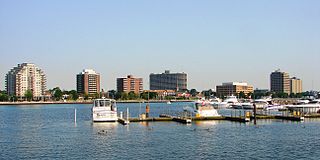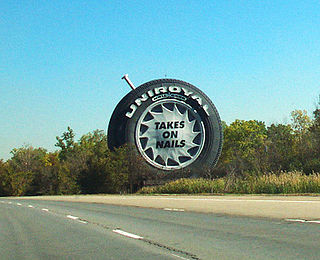Related Research Articles

Sarnia is a city in Lambton County, Ontario, Canada. It had a 2021 population of 72,047, and is the largest city on Lake Huron. Sarnia is located on the eastern bank of the junction between the Upper and Lower Great Lakes where Lake Huron flows into the St. Clair River in the Southwestern Ontario region, which forms the Canada–United States border, directly across from Port Huron, Michigan. The site's natural harbour first attracted the French explorer La Salle. He named the site "The Rapids" on 23 August 1679, when he had horses and men pull his 45-ton barque Le Griffon north against the nearly four-knot current of the St. Clair River.

Celanese Corporation, formerly known as Hoechst Celanese, is an American technology and specialty materials company headquartered in Irving, Texas. A Fortune 500 corporation, the company is the world’s leading producer of acetic acid, producing about 1.95 million tonnes per year, representing approximately 25% of global production. Celanese is also the world's largest producer of vinyl acetate monomer (VAM).

The Dow Chemical Company, officially Dow Inc., is an American multinational corporation headquartered in Midland, Michigan, United States. The company is among the three largest chemical producers in the world.

The Grand Trunk Railway was a railway system that operated in the Canadian provinces of Quebec and Ontario and in the American states of Connecticut, Maine, Michigan, Massachusetts, New Hampshire, and Vermont. The railway was operated from headquarters in Montreal, Quebec, with corporate headquarters in London, United Kingdom. It cost an estimated $160 million to build. The Grand Trunk, its subsidiaries, and the Canadian Government Railways were precursors of today's Canadian National Railway.

Lambton County is a county in Southwestern Ontario, Canada. It is bordered on the north by Lake Huron, which is drained by the St. Clair River, the county's western border and part of the Canada-United States border. To the south is Lake Saint Clair and Chatham-Kent. Lambton County's northeastern border follows the Ausable River and Parkhill Creek north until it reaches Lake Huron at the beach community of Grand Bend. The county seat is in the Town of Plympton-Wyoming.

The St. Clair Tunnel is the name for two separate rail tunnels which were built under the St. Clair River between Sarnia, Ontario and Port Huron, Michigan. The original, opened in 1891 and used until it was replaced by a new larger tunnel in 1995, was the first full-size subaqueous tunnel built in North America. It is a National Historic Landmark of the United States, and has been designated a civil engineering landmark by both US and Canadian engineering bodies.

Suncor Energy is a Canadian integrated energy company based in Calgary, Alberta. It specializes in production of synthetic crude from oil sands. In the 2020 Forbes Global 2000, Suncor Energy was ranked as the 48th-largest public company in the world.
A synthetic rubber is an artificial elastomer. They are polymers synthesized from petroleum byproducts. About 32-million metric tons of rubbers are produced annually in the United States, and of that amount two thirds are synthetic. Synthetic rubber, just like natural rubber, has many uses in the automotive industry for tires, door and window profiles, seals such as O-rings and gaskets, hoses, belts, matting, and flooring. They offer a different range of physical and chemical properties, so can improve the reliability of a given product or application. Synthetic rubbers are superior to natural rubbers in two major respects, thermal stability and resistance to oils and related compounds. They are more resistant to oxidizing agents, such as oxygen and ozone which can reduce the life of products like tires.

Butyl rubber, sometimes just called "butyl", is a synthetic rubber, a copolymer of isobutylene with isoprene. The abbreviation IIR stands for isobutylene isoprene rubber. Polyisobutylene, also known as "PIB" or polyisobutene, (C4H8)n, is the homopolymer of isobutylene, or 2-methyl-1-propene, on which butyl rubber is based. Butyl rubber is produced by polymerization of about 98% of isobutylene with about 2% of isoprene. Structurally, polyisobutylene resembles polypropylene, but has two methyl groups substituted on every other carbon atom, rather than one. Polyisobutylene is a colorless to light yellow viscoelastic material. It is generally odorless and tasteless, though it may exhibit a slight characteristic odor.

Polybutadiene [butadiene rubber BR] is a synthetic rubber. Polybutadiene rubber is a polymer formed from the polymerization of the monomer 1,3-butadiene. Polybutadiene has a high resistance to wear and is used especially in the manufacture of tires, which consumes about 70% of the production. Another 25% is used as an additive to improve the toughness of plastics such as polystyrene and acrylonitrile butadiene styrene (ABS). Polybutadiene rubber accounted for about a quarter of total global consumption of synthetic rubbers in 2012. It is also used to manufacture golf balls, various elastic objects and to coat or encapsulate electronic assemblies, offering high electrical resistivity.

The company formerly known as the United States Rubber Company, now Uniroyal, is an American manufacturer of tires and other synthetic rubber-related products, as well as variety of items for military use, such as ammunition, explosives, chemical weapons and operations and maintenance activities (O&MA) at the government-owned contractor-operated facilities. It was founded in Naugatuck, Connecticut, in 1892. It was one of the original 12 stocks in the Dow Jones Industrial Average, and became Uniroyal, Inc., as part of creating a unified brand for its products and subsidiaries in 1961.
Kraton is the trade name given to a number of high-performance elastomers manufactured by Kraton Polymers, and used as synthetic replacements for rubber. Kraton polymers offer many of the properties of natural rubber, such as flexibility, high traction, and sealing abilities, but with increased resistance to heat, weathering, and chemicals.

The Department of Munitions and Supply was the Canadian federal government ministry responsible for co-ordinating domestic industry during World War II. It was created by the Department of Munitions and Supply Act with C.D. Howe as its Minister. The Department produced armaments for the war effort and regulated the use of gasoline, silk and other strategic commodities in Canada order to prioritize their use for the war production.
The National Business Book Award is an award presented to Canadian business authors. The award, presented every year since 1985, is sponsored by Bennett Jones, The Globe and Mail, and The Walrus, DeGroote, and supported by CPA Canada and with prize management by Freedman & Associates.

Sarnia's Chemical Valley and the surrounding area are home to sixty-two facilities and refineries. A widely quoted 2007 Ecojustice Canada report showed those large industrial facilities located within 25 km of Sarnia, Ontario, Canada emitted more than 131,000 tonnes of air pollution in 2005, a toxic load of more than 1,800 kilograms per resident.

Kenneth Stanley "Boots" Adams was an American business executive, University of Kansas booster, and civic philanthropist of Bartlesville, Oklahoma. Adams began his career with the Phillips Petroleum Company in 1920 as a clerk in the warehouse department. Twelve years later, he was chosen by founder and president Frank Phillips to fill the newly created position of Assistant to the President. On April 26, 1938, Adams was elected president of Phillips Petroleum Company by the unanimous vote of the company's Board of Directors.
Buna Werke Schkopau were a chemical company specialising in the production of polymer materials such as plastics and artificial rubber. The name BUNA is derived from the technology of polymerising butadiene with sodium as a catalyst.
Norman Reginald Legge was a Canadian researcher for the Shell Oil Company and pioneer of thermoplastic elastomers, Kraton in particular.

Corunna is an unincorporated community in St. Clair Township, Lambton County, Ontario, Canada. The site of the community was surveyed by William Beresford in 1823. The community experienced a significant population boom between the 1830s and 1850s, mainly attributed to Scotch-Irish immigration. The community serves as the location of Chemical Valley, a major petrochemical and plastics manufacturing facility.
John Robert Dunn was a Polysar synthetic rubber research chemist
References
- 1 2 Kennedy, J. de N. (1950). History of the Department of Munitions and Supply: Canada in the Second World War. Canada: King's Printer and Controller of Stationery. pp. 190–194.
- ↑ Wilson, Kenneth R. (April 1, 1944). "Rubber Crisis". No. Vo. 55. Maclean's Magazine.
- ↑ https://legionmagazine.com/en/the-rush-for-rubber
- ↑ Lauriston, Victor (1949). Lambton County's Hundred Years: 1849-1949. Sarnia: Haimes Frontier Publishing Co. pp. 307–308.
- ↑ Canada Year Book. Canada: Statistics Canada. 1943–1944. p. 356.
- ↑ "Ground Broken for Synthetic Rubber Plant". The Observer. The Observer. July 23, 1942.
- 1 2 Environment Canada and the Ontario Ministry of the Environment. Pollution of the St. Clair River (Sarnia area) (PDF) (Report).
- ↑ " "History of Spills". 2012-04-17.
- 1 2 Tom Spears (March 11, 1989). "The Dirty Dozen". The Toronto Star. p. D1 and D5.
- ↑ Bellamy, Matthew J., Profiting The Crown: Canada's Polymer Corporation, 1942-1990, McGill-Queen's Press - MQUP, (2005) ISBN 0-7735-2815-6, page ii
- ↑ The Art and Design of Canadian Bank Notes (PDF). Bank of Canada. 6 December 2006. ISBN 0660632462.
- ↑ Bellamy, Matthew J., Profiting The Crown: Canada's Polymer Corporation, 1942-1990, McGill-Queen's Press - MQUP, (2005) ISBN 0-7735-2815-6
- ↑ "Finding aid to Polysar Archive fonds, Library and Archives Canada".